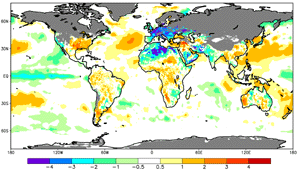 Satellite Derived Global Temperature Anomalies November 1998 National Climatic Data Center Asheville, NC |

Overview of the U.S.
- The month of November 1998, was the 7th warmest for the U.S. as a whole. Precipitation, averaged over the U.S., was near normal; The eastern third of the U.S. was dry and the west was wet. Like January through October, the period January through November 1998 was the 2nd warmest and 3rd wettest such period on record. The warmest year was 1934 with a mean value for Jan-Nov of 56.6 degrees F. The mean value for Jan-Nov, 1998, was 56.3 degrees F. The normal value for the period Jan-Nov is 54.2 degrees F.
- Looking at October and November combined, the national average for temperature was also the 7th warmest on record with the warmest areas being the south, southeast, and north central regions. As a whole, the U.S. averaged the 18th wettest on record with the west north central having the wettest October-November on record. The driest region was the southeast with it being the 9th driest Oct-Nov on record.
- For the period June through November,1998, the U.S. experienced the 3rd warmest such period on record, with the south and northwest regions having the second warmest June-Nov on record.
- The past 12 months, December 1997 through November 1998, have been the second warmest and third wettest on record for the U.S. For this 12-month period, the northeast and east north central regions have set new records for warmest Dec-Nov on record. The coldest region was the west region.
PRECIPITATION AND TEMPERATURE RANKS, BASED
ON THE PERIOD 1895-1998. 1 = DRIEST/COLDEST,
104 = WETTEST/WARMEST FOR NOVEMBER 1998,
104 = WETTEST/WARMEST FOR OCT-NOV 1998,
104 = WETTEST/WARMEST FOR JUN-NOV 1998,
103 = WETTEST/WARMEST FOR DEC 1997-NOV 1998.
NOV OCT-NOV JUN-NOV DEC 1997-
REGION 1998 1998 1998 NOV 1998
------ ---- --------- --------- ---------
PRECIPITATION:
NORTHEAST 9 19 36 82
EAST NORTH CENTRAL 54 84 63 79
CENTRAL 25 50 78 91
SOUTHEAST 30 9 10 88
WEST NORTH CENTRAL 92 104 101 90
SOUTH 65 95 71 73
SOUTHWEST 49 84 74 82
NORTHWEST 90 77 64 83
WEST 83 78 89 102
NATIONAL 60 87 78 101
TEMPERATURE:
NORTHEAST 72 71 77 103
EAST NORTH CENTRAL 95 98 101 103
CENTRAL 91 89 96 102
SOUTHEAST 90 94 102 96
WEST NORTH CENTRAL 85 92 97 99
SOUTH 94 98 103 101
SOUTHWEST 83 74 89 81
NORTHWEST 89 65 103 98
WEST 57 40 65 46
NATIONAL 98 98 102 102
7th Warmest November for U.S. since 1895

larger image
Preliminary data for November 1998 indicate that temperature averaged across the contiguous United States was much above the long-term mean ranking as the 7th warmest November since 1895.
The preliminary national standardized temperature index ranked November 1998 as the sixth warmest November on record.
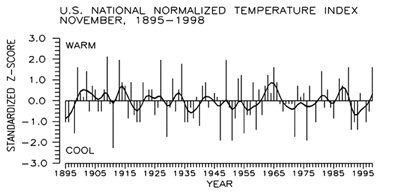
larger image
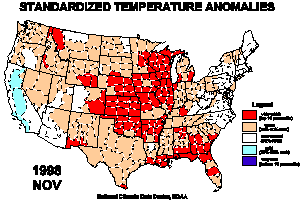 larger image |
The geographical pattern of November warmth can be seen in this temperature anomaly map. The bright red areas indicate very warm temperature anomalies (i.e., anomalies in the top ten percentile for the area, or warmer than 1.28 standard deviations above the mean). |
November 1998 was the 45th wettest November since 1895
| About 8% of the country had monthly precipitation in the extremely wet (top 10 percentile) category, while another 8% was extremely dry (bottom 10 percentile). |
 larger image |

larger image
November 1998 was the 45th wettest November since 1895.
The preliminary national standardized precipitation index ranked November 1998 as the 46th wettest November on record. This standardized z-score is estimated to be accurate to within 0.159 index units.

larger image
| November 1998 was characterized by dichotomous precipitation extremes in the contiguous United States. This continues a pattern of balanced precipitation extremes that has characterized much of 1998. |
 larger image |
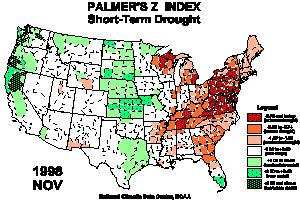 larger image |
The geographical pattern of short term monthly moisture deficit (red) and moisture surplus (green) is shown by the Palmer Z Index. November 1998 was unusually wet over large parts of the Far West and Great Plains, and unusually dry over large areas from the Deep South nortward to New England and the Great Lakes. |
| The geographic patterns of long-term (cumulative) monthly drought (red) and wetness (green) are represented by the Palmer Drought Index. The PDI is best used as a drought/wet spell indicator for reservoir and groundwater applications. |
 larger image |
EXTREMES, 1961-90 NORMALS, AND 1998 VALUES
FOR NOVEMBER. IT SHOULD BE NOTED THAT THE
1998 VALUES WILL CHANGE WHEN THE FINAL DATA
ARE PROCESSED.
PRECIPITATION (INCHES)
DRIEST WETTEST NORMAL 1998
REGION VALUE YEAR VALUE YEAR PCPN PCPN
------ ---------- ---------- ------ ------
NORTHEAST .88 1917 6.34 1983 3.84 1.71
EAST NORTH CENTRAL .20 1904 4.03 1931 1.89 1.75
CENTRAL .71 1904 7.71 1985 3.53 2.22
SOUTHEAST .83 1931 8.39 1948 3.30 2.06
WEST NORTH CENTRAL .06 1939 1.63 1896 .74 1.14
SOUTH .20 1949 5.21 1940 2.63 2.75
SOUTHWEST .06 1904 2.37 1905 .90 .68
NORTHWEST .30 1936 7.61 1909 3.78 5.47
WEST .01 1929 5.56 1926 2.22 2.91
NATIONAL .88 1917 3.76 1983 2.32 2.18*
* PRELIMINARY VALUE, CONFIDENCE
INTERVAL + OR - .20 INCHES
TEMPERATURE (DEGREES F)
COLDEST WARMEST NORMAL 1998
REGION VALUE YEAR VALUE YEAR TEMP TEMP
------ ---------- ---------- ------ ------
NORTHEAST 32.3 1901 44.7 1931 38.7 39.5
EAST NORTH CENTRAL 24.9 1959 39.8 1899 33.1 37.4
CENTRAL 35.9 1976 51.4 1931 44.2 46.9
SOUTHEAST 48.2 1976 62.4 1985 55.0 57.7
WEST NORTH CENTRAL 17.3 1985 40.3 1949 30.9 34.8
SOUTH 45.5 1976 58.7 1909 52.5 55.8
SOUTHWEST 36.1 1972 46.9 1949 41.4 43.4
NORTHWEST 27.2 1985 42.8 1899 37.0 39.7
WEST 40.0 1994 51.8 1949 46.0 46.6
NATIONAL 38.2 1911 46.1 1909 42.7 45.4*
* PRELIMINARY VALUE, CONFIDENCE
INTERVAL + OR - .6 DEG. F.
2nd Warmest January-November for U.S. since 1895
| About 74% of the country was much warmer than normal while nearly zero percent of the country was much cooler than normal. |
 larger image |
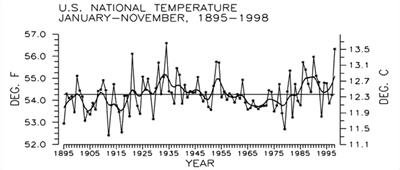
larger image
Preliminary data indicate that the period January-November 1998 was the second warmest such period since 1895 for the contiguous United States. The 1998 year-to-date national averaged temperature was 56.3°F. The warmest January-November, at 56.6 degrees F, occurred in 1934, the warmest year on record. The 1961-1990 normal temperature for January-November is 54.2 degrees F. Ten of the last thirteen years have seen January through November as above to much-above the long-term mean.
The preliminary national standardized temperature index ranked January-November 1998 as the second warmest January-November since records began in 1895.

larger image
3rd Wettest January-November for U.S. since 1895
 larger image |
With a national averaged precipitation value of inches, preliminary data suggest that January-November 1998 was the wettest such 11-month period on record for the contiguous United States. The 1961-1990 normal for the same period is inches. The second wettest such eleven-month period was January-November 1973 with inches of precipitation. About 27% of the country was much wetter than normal while about one percent of the country was much drier than normal. |
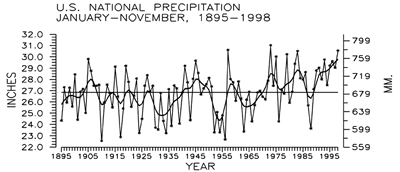
larger image
Preliminary precipitation data indicate that the period January-November 1998 was the third wettest such period since 1895 for the contiguous United States. The last ten years have found January through November precipitation at above to much-above the long-term mean.
The preliminary national year-to-date standardized precipitation index ranked January-November 1998 as the second wettest January-November since 1895.

larger image
TEMPERATURE AND PRECIPITATION RANKINGS FOR
JANUARY-NOVEMBER 1998, BASED ON THE PERIOD 1895-1998.
1 = DRIEST/COLDEST, 104 = WETTEST/HOTTEST.
REGION PRECIPITATION TEMPERATURE
------ ------------- -----------
NORTHEAST 88 104
EAST NORTH CENTRAL 86 104
CENTRAL 94 103
SOUTHEAST 79 100
WEST NORTH CENTRAL 93 99
SOUTH 64 102
SOUTHWEST 79 89
NORTHWEST 94 101
WEST 103 48
NATIONAL 102 103
EXTREMES, 1961-90 NORMALS, AND 1998 VALUES FOR JANUARY-NOVEMBER
PRECIPITATION (INCHES)
DRIEST WETTEST NORMAL 1998
REGION VALUE YEAR VALUE YEAR PCPN PCPN
------ ---------- ---------- ------ ------
NORTHEAST 29.53 1941 48.24 1996 38.18 40.80
EAST NORTH CENTRAL 19.03 1910 35.01 1951 29.06 31.41
CENTRAL 28.89 1901 48.60 1950 39.61 45.09
SOUTHEAST 34.32 1954 59.24 1929 47.16 50.42
WEST NORTH CENTRAL 10.91 1934 22.15 1915 16.27 19.13
SOUTH 22.14 1956 44.31 1957 33.23 34.25
SOUTHWEST 7.31 1956 20.88 1941 12.68 13.75
NORTHWEST 13.75 1929 30.87 1983 23.47 27.74
WEST 7.94 1929 26.48 1983 14.18 25.70
NATIONAL 22.54 1910 31.05 1973 27.16 30.57
TEMPERATURE (DEGREES F)
COLDEST WARMEST NORMAL 1998
REGION VALUE YEAR VALUE YEAR TEMP TEMP
------ ---------- ---------- ------ ------
NORTHEAST 45.3 1904 50.8 1998 47.8 50.8
EAST NORTH CENTRAL 42.2 1917 49.8 1998 45.8 49.8
CENTRAL 52.9 1979 58.8 1921 55.1 58.1
SOUTHEAST 62.2 1940 66.3 1921 63.8 65.8
WEST NORTH CENTRAL 42.1 1950 49.1 1934 45.5 47.7
SOUTH 61.9 1979 66.4 1921 63.7 66.3
SOUTHWEST 51.2 1917 56.4 1934 53.6 54.5
NORTHWEST 45.4 1955 52.0 1934 48.3 50.3
WEST 54.6 1912 59.4 1934 56.5 56.2
NATIONAL 52.4 1912 56.6 1934 54.2 56.3
2nd Warmest Autumn for U.S. since 1895
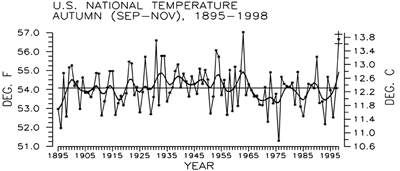
larger image
Preliminary data for Autumn (September-November) 1998 indicate that temperature averaged across the contiguous United States was much above the long-term mean ranking as the 2nd warmest Autumn season since 1895. Less than one percent of the country was much cooler than normal while a full two-thirds of the country was much warmer than normal
The preliminary national Autumn standardized temperature index ranked September-November 1998 as the third warmest Autumn on record.

larger image
24th Wettest Autumn for U.S. since 1895
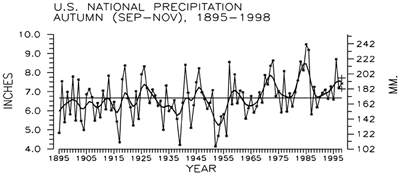
larger image
Preliminary data for November 1998 suggests that Autumn 1998 was the 24th wettest Autumn since 1895. Sixteen percent of the country was much wetter than normal while nearly 6% of the country was much drier than normal
The preliminary national Autumn standardized precipitation index ranked September-November 1998 as the 27th wettest Autumn on record.

larger image
TEMPERATURE AND PRECIPITATION RANKINGS FOR
SEP-NOV 1998, BASED ON THE PERIOD 1895-1998.
1 = DRIEST/COLDEST, 104 = WETTEST/HOTTEST.
REGION PRECIPITATION TEMPERATURE
------ ------------- -----------
NORTHEAST 8 82
EAST NORTH CENTRAL 56 102
CENTRAL 36 102
SOUTHEAST 41 95
WEST NORTH CENTRAL 94 102
SOUTH 92 103
SOUTHWEST 73 90
NORTHWEST 66 96
WEST 85 60
NATIONAL 81 103
EXTREMES, 1961-90 NORMALS, AND 1998 VALUES
FOR SEPTEMBER-NOVEMBER
PRECIPITATION (INCHES)
DRIEST WETTEST NORMAL 1998
REGION VALUE YEAR VALUE YEAR PCPN PCPN
------ ---------- ---------- ------ ------
NORTHEAST 5.01 1908 15.54 1977 10.82 7.44
EAST NORTH CENTRAL 2.92 1976 11.82 1941 7.96 7.38
CENTRAL 3.99 1953 14.92 1926 10.20 8.39
SOUTHEAST 4.27 1931 17.71 1929 10.79 9.62
WEST NORTH CENTRAL 1.21 1952 6.41 1946 3.44 4.63
SOUTH 3.79 1917 13.88 1986 9.19 11.95
SOUTHWEST .95 1956 6.51 1972 3.48 3.62
NORTHWEST 1.51 1936 11.35 1973 7.16 8.13
WEST .38 1929 7.46 1982 3.85 4.74
NATIONAL 4.14 1952 9.48 1985 7.11 7.44*
* PRELIMINARY VALUE, CONFIDENCE
INTERVAL + OR - .29 INCHES
TEMPERATURE (DEGREES F)
COLDEST WARMEST NORMAL 1998
REGION VALUE YEAR VALUE YEAR TEMP TEMP
------ ---------- ---------- ------ ------
NORTHEAST 45.2 1917 53.8 1931 49.1 50.6
EAST NORTH CENTRAL 41.6 1896 52.5 1931 46.6 50.7
CENTRAL 49.9 1976 61.2 1931 55.4 58.5
SOUTHEAST 59.5 1976 67.9 1919 63.9 66.3
WEST NORTH CENTRAL 38.0 1985 50.3 1963 44.5 48.4
SOUTH 58.2 1976 68.2 1931 63.2 67.0
SOUTHWEST 49.9 1912 56.1 1963 52.9 54.5
NORTHWEST 41.9 1985 50.3 1963 47.3 49.4
WEST 53.2 1916 59.2 1995 56.3 56.5
NATIONAL 51.3 1976 57.0 1963 54.0 56.7*
* PRELIMINARY VALUE, CONFIDENCE
INTERVAL + OR - .3 DEG. F.

Overview of the Globe
- When the land and ocean temperature anomalies are combined, November 1998 was the second warmest November on record. The global anomaly was 1.00 deg.F (0.56 deg.C) above the 1880-1997 mean.
- Regionally, the U.S. continued to experience near record warmth, while Europe and north Africa were well below normal. The global land temperature for November 1998 was the fourth warmest on record.
- Ocean temperatures were 0.82 deg.F (0.46 deg.C) above the 1880-1997 mean. None-the-less they were cooler than the anomaly during November 1997, when mature El Niño conditions dominated the tropical Pacific.
Year-to-Date 1998 remains warmest on record
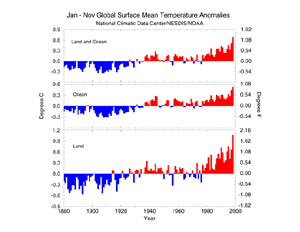 larger image Global Mean Temperature Anomalies January-November 1998 |
 larger image The period January through November 1998 was the warmest Jan-Nov on record with a global mean temperature of 14.69 deg C / 58.42 deg F. This is 0.68 deg C / 1.23 deg F above the 1880-1997 mean of 14.0 deg C / 57.19 deg F and exceeding the previous record set in 1997 by 0.18 deg C / 0.32 deg F. |
Global Mean for November falls below Record Set in 1997
 larger image Preliminary data suggest that November 1998 was the second warmest November on record. The warmest November was in 1997. At 14.08 deg C / 56.27 deg F, November 1998 was 0.59 deg C / 1.07 deg F above the 1880-1997 mean global temperature of 12.9 deg C / 55.2 deg F. November 1997 set the record at .68 deg C / 1.22 deg F above the mean. |
 larger image Global Temperature Anomalies November 1998 |
Current data are based on preliminary reports from River Forecast Center stations and First and Second Order airport stations obtained from the National Weather Service (NWS) Climate Prediction Center and real time Global Telecommunications System (GTS) monthly CLIMAT summaries. THE CURRENT DATA SHOULD BE USED WITH CAUTION. These preliminary data are useful for estimating how current anomalies compare to the historical record, however the actual values and rankings for the current year may change as the final data arrive at NCDC and are processed.
The following NCDC datasets are used for the historical U.S. data: the climate division drought database (TD-9640), and the hurricane datasets (TD-9636 and TD-9697). It should be noted that the climate division drought database consists of monthly data for 344 climate divisions in the contiguous United States. These divisional values are calculated from the 6000+ station Cooperative Observer network.
As GTS CLIMAT data are being received, scientists at The National Oceanic and Atmospheric Administration's National Climatic Data Center are automatically updating The Global Historical Climatology Network data base to maintain a global climate perspective in near real-time.
For more information, refer to ...
Global Historical
Climatology Network (GHCN)
The
Global Temperature Anomalies
SSMI
Derived Products NOAA's National Climatic Data Center is the
world's largest active archive of weather data. The preliminary
temperature and precipitation rankings are available from the
center by calling: 828-271-4800 or on the World Wide Web at:
http:/www.ncdc.noaa.gov/ol/documentlibrary/cvb.html
Historical precipitation and temperature ranking maps are also available on the Internet at: https://nic.fb4.noaa.gov//products/analysis_monitoring/regional_monitoring/usa.html.
NOAA works closely with the academic and science communities on climate-related research projects to increase the understanding of El Niño and improve forecasting techniques. NOAA's Climate Prediction Center monitors, analyzes and predicts climate events ranging from weeks to seasons for the nation. NOAA also operates the network of data buoys and satellites that provide vital information about the ocean waters, and initiates research projects to improve future climate forecasts. The long lead climate outlooks are available on the Internet at: https://nic.fb4.noaa.gov/.
 NOAA's National Centers for Environmental Information
NOAA's National Centers for Environmental Information
